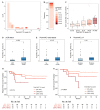Negative Relationship between Post-Treatment Stromal Tumor-Infiltrating Lymphocyte (TIL) and Survival in Triple-Negative Breast Cancer Patients Treated with Dose-Dense Dose-Intense NeoAdjuvant Chemotherapy
- PMID: 35267639
- PMCID: PMC8909288
- DOI: 10.3390/cancers14051331
Negative Relationship between Post-Treatment Stromal Tumor-Infiltrating Lymphocyte (TIL) and Survival in Triple-Negative Breast Cancer Patients Treated with Dose-Dense Dose-Intense NeoAdjuvant Chemotherapy
Abstract
Background: Patients with triple-negative breast cancers (TNBC) have a poor prognosis unless a pathological complete response (pCR) is achieved after neoadjuvant chemotherapy (NAC). Few studies have analyzed changes in TIL levels following dose-dense dose-intense (dd-di) NAC. Patients and methods: From 2009 to 2018, 117 patients with TNBC received dd-di NAC at our institution. We aimed to identify factors associated with pre- and post-NAC TIL levels, and oncological outcomes relapse-free survival (RFS), and overall survival (OS). Results: Median pre-NAC and post-NAC TIL levels were 15% and 3%, respectively. Change in TIL levels with treatment was significantly correlated with metabolic response (SUV) and pCR. High post-NAC TIL levels were associated with a weak metabolic response after two cycles of NAC, with the presence of residual disease and nodal involvement at NAC completion. In multivariate analyses, high post-NAC TIL levels independently predicted poor RFS and poor OS (HR = 1.4 per 10% increment, 95%CI (1.1; 1.9) p = 0.014 and HR = 1.8 per 10% increment 95%CI (1.3−2.3), p < 0.0001, respectively). Conclusion: Our results suggest that TNBC patients with TIL enrichment after NAC are at higher risk of relapse. These patients are potential candidates for adjuvant treatment, such as immunotherapy, in clinical trials.
Keywords: dose dense neoadjuvant chemotherapy; stromal tumor-infiltrating lymphocyte; triple negative breast cancers.
Conflict of interest statement
The authors declare no conflict of interest.
Figures




Similar articles
-
Prognostic Impact of Stromal Immune Infiltration before and after Neoadjuvant Chemotherapy (NAC) in Triple Negative Inflammatory Breast Cancers (TNIBC) Treated with Dose-Dense Dose-Intense NAC.Cancers (Basel). 2020 Sep 17;12(9):2657. doi: 10.3390/cancers12092657. Cancers (Basel). 2020. PMID: 32957722 Free PMC article.
-
Prognostic significance of tumor-infiltrating CD8+ and FOXP3+ lymphocytes in residual tumors and alterations in these parameters after neoadjuvant chemotherapy in triple-negative breast cancer: a retrospective multicenter study.Breast Cancer Res. 2015 Sep 4;17(1):124. doi: 10.1186/s13058-015-0632-x. Breast Cancer Res. 2015. PMID: 26341640 Free PMC article.
-
Interaction between Molecular Subtypes and Stromal Immune Infiltration before and after Treatment in Breast Cancer Patients Treated with Neoadjuvant Chemotherapy.Clin Cancer Res. 2019 Nov 15;25(22):6731-6741. doi: 10.1158/1078-0432.CCR-18-3017. Epub 2019 Sep 12. Clin Cancer Res. 2019. PMID: 31515462
-
Prognostic value of tumor-infiltrating lymphocytes in patients with triple-negative breast cancer: a systematic review and meta-analysis.BMC Cancer. 2020 Mar 4;20(1):179. doi: 10.1186/s12885-020-6668-z. BMC Cancer. 2020. PMID: 32131780 Free PMC article.
-
A nomogram to predict pathologic complete response (pCR) and the value of tumor-infiltrating lymphocytes (TILs) for prediction of response to neoadjuvant chemotherapy (NAC) in breast cancer patients.Breast Cancer Res Treat. 2019 Jan;173(2):255-266. doi: 10.1007/s10549-018-4981-x. Epub 2018 Oct 15. Breast Cancer Res Treat. 2019. PMID: 30324273 Review.
Cited by
-
Characteristics of recurrence, predictors for relapse and prognosis of rapid relapse triple-negative breast cancer.Front Oncol. 2023 Feb 16;13:1119611. doi: 10.3389/fonc.2023.1119611. eCollection 2023. Front Oncol. 2023. PMID: 36874102 Free PMC article.
-
Prioritizing cases from a multi-institutional cohort for a dataset of pathologist annotations.J Pathol Inform. 2024 Nov 16;16:100411. doi: 10.1016/j.jpi.2024.100411. eCollection 2025 Jan. J Pathol Inform. 2024. PMID: 39720416 Free PMC article.
-
Development and validation of a nomogram for predicting rapid relapse in triple-negative breast cancer patients treated with neoadjuvant chemotherapy.Front Cell Dev Biol. 2024 Sep 2;12:1417366. doi: 10.3389/fcell.2024.1417366. eCollection 2024. Front Cell Dev Biol. 2024. PMID: 39286481 Free PMC article.
-
Multiomics technologies for comprehensive tumor microenvironment analysis in triple-negative breast cancer under neoadjuvant chemotherapy.Front Oncol. 2023 May 22;13:1131259. doi: 10.3389/fonc.2023.1131259. eCollection 2023. Front Oncol. 2023. PMID: 37284197 Free PMC article. Review.
References
-
- Lin N.U., Vanderplas A., Hughes M.E., Theriault R.L., Edge S.B., Wong Y.-N., Blayney D.W., Niland J.C., Winer E.P., Weeks J.C. Clinicopathologic Features, Patterns of Recurrence, and Survival among Women with Triple-Negative Breast Cancer in the National Comprehensive Cancer Network. Cancer. 2012;118:5463–5472. doi: 10.1002/cncr.27581. - DOI - PMC - PubMed
-
- Denkert C., von Minckwitz G., Brase J.C., Sinn B.V., Gade S., Kronenwett R., Pfitzner B.M., Salat C., Loi S., Schmitt W.D., et al. Tumor-Infiltrating Lymphocytes and Response to Neoadjuvant Chemotherapy with or without Carboplatin in Human Epidermal Growth Factor Receptor 2-Positive and Triple-Negative Primary Breast Cancers. J. Clin. Oncol. 2015;33:983–991. doi: 10.1200/JCO.2014.58.1967. - DOI - PubMed
LinkOut - more resources
Full Text Sources

